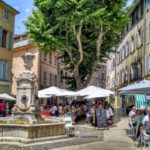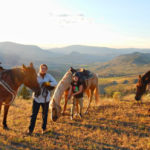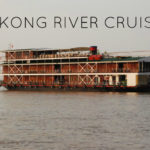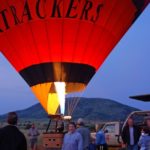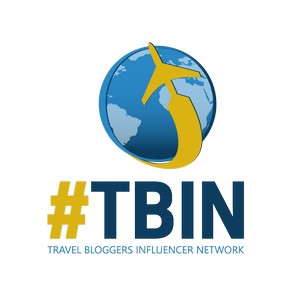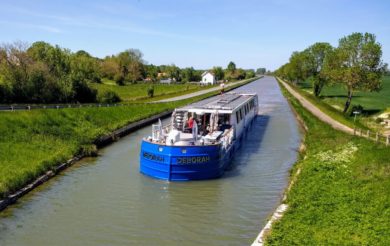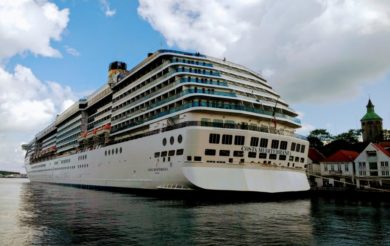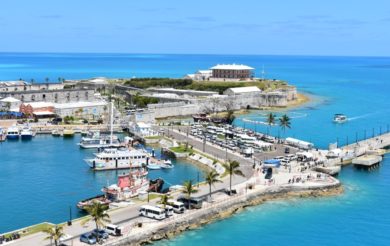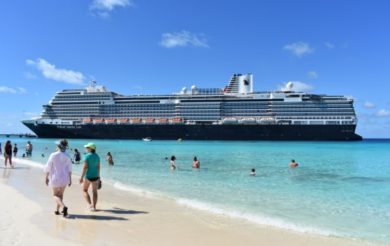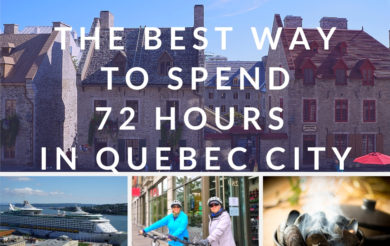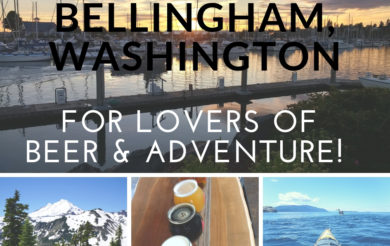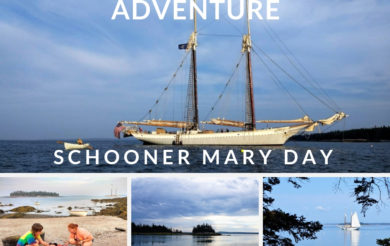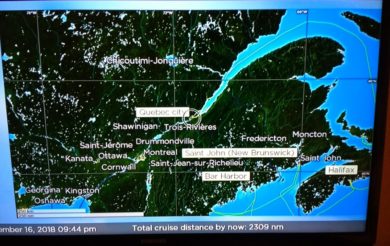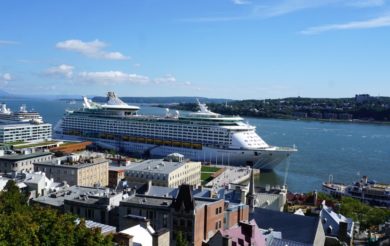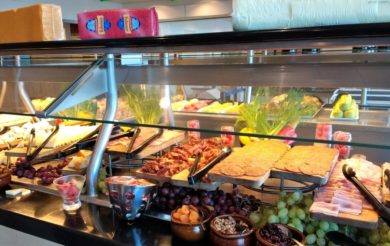7 Reasons to Add Myanmar to Your Bucket List
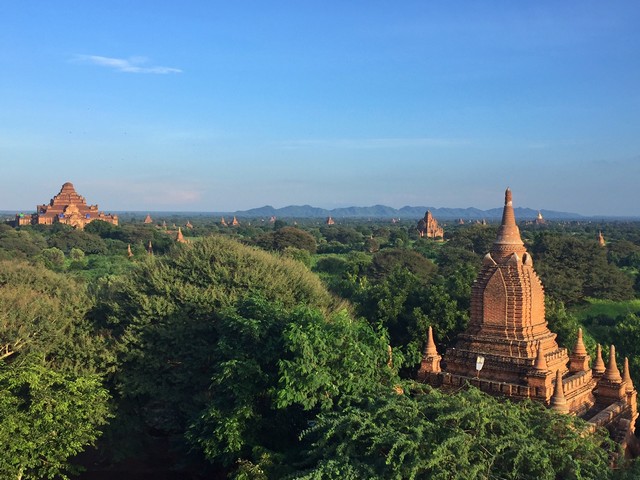
7 Reasons to Add Myanmar to Your Bucket List (photo by Marianne Rogerson – www.mumonthemove.com)
7 Reasons to Add Myanmar to Your Bucket List
Article by Barbara Hopper
Photographs by Marianne Rogerson from MumOnTheMove.com
Myanmar, the hidden gem of southeast Asia, highlights the contrasts between modernity and traditionalism. Effectively isolated from the world for almost five decades by the former repressive military regime, the country, also known as Burma, is on the cusp of massive change. The military junta officially ended in 2011. While they continue to wield considerable influence, the military has substantially loosened its grip. People openly discuss divisive issues. The government has released political prisoners. The advent of these changes resulted in steadily increasing tourism, as well as the influx of foreign trade and investments. Despite the changes, many of the sites and cultural aspects remain uniquely Burmese.
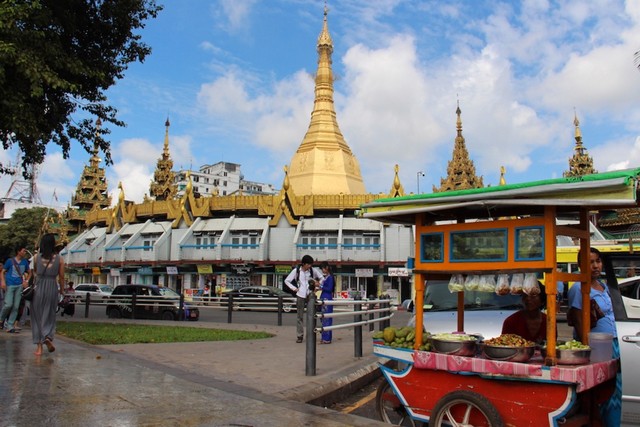
Sule Pagoda in Yangon. (photo by Marianne Rogerson – www.mumonthemove.com)
Visit the Shwedagon Pagoda in Yangon
Grown weary of pagodas and Buddhist statues, I tried to minimize my disinterest. I was not expecting much. Nonetheless, immediately upon entering Shwedagon I was rendered speechless. Awe-inspiring, breathtaking…these are merely words that cannot adequately describe the sensations coursing through me. Like a kid at Christmas, my attention wandered everywhere.
A whiff of burning candles and incense infused the atmosphere. Kneeling, red-robed monks prayed. Parents educated young children dressed in their finest longyis on Buddhist practices. Interspersed with periodic reverberations of a bell, worshipers lit candles, tendering flowers and incense. They poured water on an image of Buddha while proffering a prayer and a wish. Others knelt in supplication or meditation. Many of the rituals and architecture indicates an origin in Hindu astrology.
Built 2500 years old, the Shwedagon Pagoda is the holiest site for Burmese Buddhists. Encased in hundreds of gold plates, the top stupa is encrusted with an astounding 4531 diamonds, culminating in a 72-carat diamond. Shwedagon Pagoda is open daily from 4:00 A.M to 10:00 P.M. Admission is US$8.00.
Dress Code
Cover knees and shoulders should be covered. Sleeves should be elbow-length. Shoes and socks are not permitted.
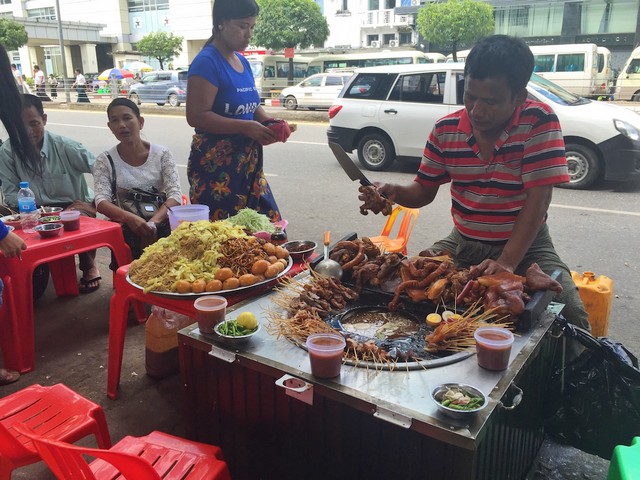
Yangon Street Food. (photo by Marianne Rogerson – www.mumonthemove.com)
Explore the Early Morning Markets in Downtown Yangon
Before the sweltering heat becomes oppressive, stroll down the bustling streets of downtown. Explore the myriad and colorful fresh fruits and vegetable stands. You’ll see papayas, mangos, bananas, avocados, snapdragon and jackfruit, to name a few. Watch your step. Just beneath the cracked concrete sidewalks contains the city’s sewer system. The rotting stench wafting from the ground, compounded with the putrid reek of the durian fruit is peppered with the scents of frying oils, fish, pork, and steaming noodles.
Try one of the many teahouses where you can taste mohinga. This national dish consists of noodles served in a fish broth. Social hubs, the tea houses serve as ideal people-watching arenas. We tried 999 Shan Noodle, but the tea houses are everywhere.
The Ancient City of Bagan
No visit to Myanmar would be complete without exploring the ancient city of Bagan, formerly known as Pagan. In its heyday, nearly 10,000 temples, stupas, and monasteries dotted the landscape. These brick and sandstone architectural wonders were built from 1044-1287. King Anawratha, who unified the country known as Burma, built the first temples. He and his successors believed this would help them attain spiritual merit. Today there are about 2200 left, some in various states of crumbling disrepair.
In August 2016, an earthquake severely damaged many of the structures. Currently a restoration effort is underway. Definitely check out some of the temples for an astounding view of either sunrise or sunset. Be sure to get a map which provides the locations of the more popular temples, as well as the ones off the beaten path.
Rent an ebike for about 5000-12,000 kyet (pronounced chet), which is roughly about US$50-100. It’s a great sense of freedom as you explore the countless paths. Riding through the streets on a sultry, hot, humid day feel the sweat dissipate as the gentle wind caresses your body. What a marvelous respite! Beware though. The major streets and sandy pathways to the temples can get pretty dusty.
If you don’t mind the penetrating heat, renting a bicycle is considerable cheaper. It should run about 2000 kyet a day, or $2.00. An alternative noteworthy transport to visit the temples is a horse carriage. Although from what I hear, anticipate a jarring, dusty ride. Expect to pay around $20.00.
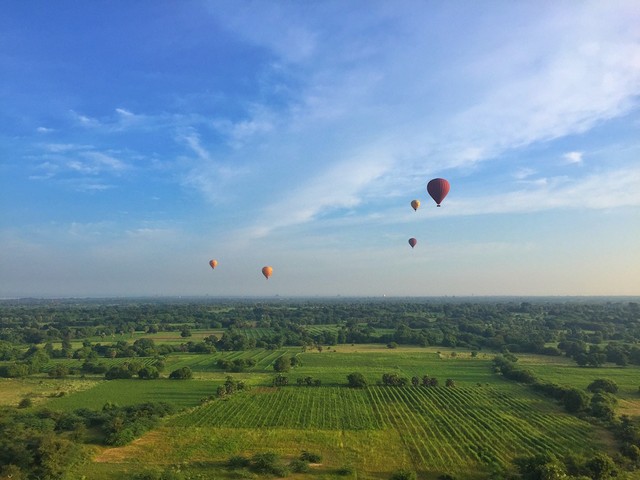
Balloons Over Bagan. (photo by Marianne Rogerson – www.mumonthemove.com)
Treat Yourself to a Sunrise Hot Air Balloon Ride over Bagan
Note the balloons only fly if the weather permits. Observing the city from above, combined with the cool, crisp air and the gentle drift of the balloon enriches your experience. Scattered among the temples are operative agricultural villages. Notice the red temples basked in a golden hue scattered among the oxen plowing vibrant green fields. The slate-gray Irrawaddy River can be sighted in the background.
Two companies offer balloon rides. Oriental Ballooning is $395.00 with advanced reservations. This includes transportation to and from your hotel, a light breakfast (more like a snack) before takeoff, and champagne at the end of the ride. Each balloon holds 12 people. Balloons Over Bagan costs $330.00. Their balloons hold 16 passengers. Their services are similar to Oriental Ballooning.
Enjoy a Visit to Kalaw
This picturesque, small mountain town in the western Shan State was developed by the British as a hill station…a destination to escape from the brutal heat and humidity of lower elevations. Many British colonial buildings still remain. The market is the hub of the town, where nearby villagers sell their produce. Kalaw is rapidly becoming a trekking magnet. Options range from a trek lasting a few hours, to those lasting two or three days. If you have the energy and time, you might want to check out one of the longer treks…either to Inle Lake or Pindaya in order to glimpse the culture of the local hill tribes.
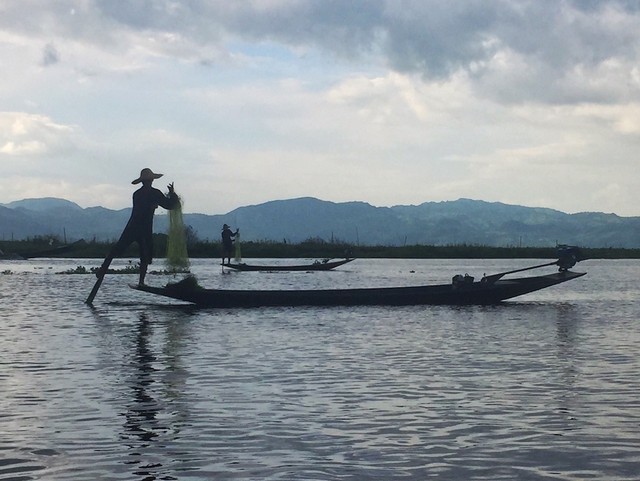
Inle Lake Fisherman. (photo by Marianne Rogerson – www.mumonthemove.com)
Inle Lake
A poorer, distant cousin to Venice in some alternate universe, this shallow 13.5-mile freshwater lake sports a host of long-standing villages. Embarking from the gateway town of Nyaungshwe hire a wooden longboat and operator for a day. Granted the boats are noisy, though the reverberating whir of the engine soon blends into the background. From the green, brackish water of the narrow feeder channel, the slate gray of the lake majestically appears. The picturesque, tree-lined, smoothly sloping hills augment the scene’s serenity. The famous one-legged rowing fishermen, unique to this area, dot the water. They truly are a sight to behold as they perform an acrobatic balancing act on one leg.
Cruising onward, lotus plants, reeds, and floating gardens gently undulate with the current. Villages with one and two-story wooden and bamboo huts pepper the waterways. You may spot a young woman washing her hair. In an acknowledgement of the modern world, many now have satellite dishes.
A stop at a textile manufacturer in Paw Khon, reveals that Inle Lake has been an important weaving center in Myanmar for over a century. Outside women and men cut the lotus stem, drawing out the fibers for thread, which will ultimately be woven into scarves. Everything is done by hand. Inside you can take in the clattering of the looms as the women work to turn the thread of silk and cotton into patterns which will ultimately become longyis or blouses.
Nanpan hosts a cheroot factory. Six women sit at two low tables hand making cigars. Blending bark, stems, roots, a small amount of tobacco, and various flavorings such as anise, tamarind, and honey, they create a surprisingly mild cigar popular among men and women in Burma.
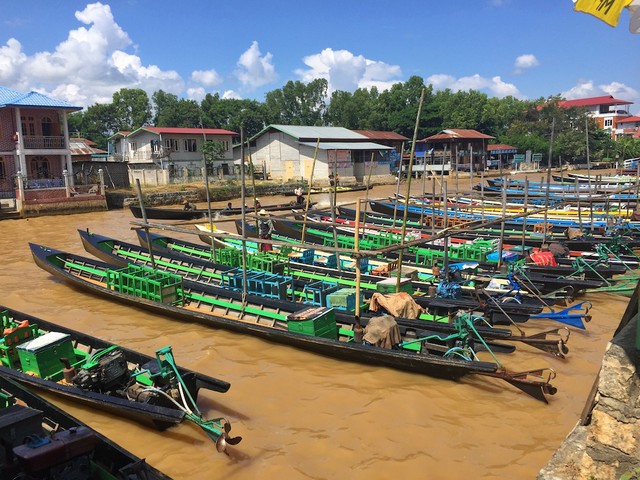
Inle Lake Longboats. (photo by Marianne Rogerson – www.mumonthemove.com)
In Nyaungshwe rent a bike and check out the Red Mountain Estate Winery for some wine tasting. The emerald green sprawling estate sits atop a hill overlooking the lake.
Be sure to stop for lunch or dinner at the Bamboo Hut in War Daw village, just outside of Nyaungshwe. The delectable food is fresh. The fruit and vegetables are hand-picked from their garden. How much fresher can you get?
The People
Last but not least, the local people are delightful. Ready with a smile and eager to help, the Burmese are among the most welcoming, readily embracing tourists. Travel is safe. Solo women travelers need not fear. Just use common sense. Dress and act appropriately. The people are basically conservative in nature. No longer isolated from the world, the influx of money from tourism, businesses, and international aid is slowly bringing Myanmar into the 21st century.
If You Go
For $50.00 you can get a tourist E-visa good for 28 days.
When to Go
Late October through March is high season, after the monsoons and before the heat becomes totally unbearable. Hotels and guesthouses can fill, so it is important to book reservations at least a month in advance. Most places have on-line booking capabilities.
Getting There
A growing number of airlines offer direct flights into Yangon from such cities as Bangkok, Calcutta, Hong Kong, Singapore, and Seoul.
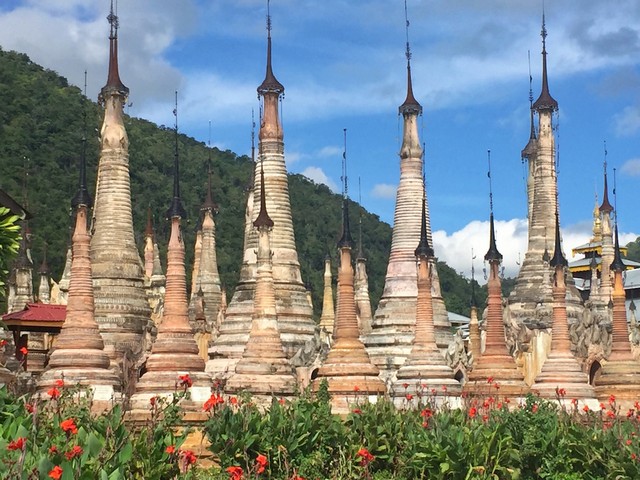
Samkar Pagoda. (photo by Marianne Rogerson – www.mumonthemove.com)
Traveling Around the Country
Flying is the quickest way to travel to various cities. Yangon International Airport is the main hub. There are several local airlines including Myanmar National Airlines (flymna.com) and Air Bagan (airbagan.com). It is cheaper to book domestic flights from within the country utilizing a travel agency.
Busses are cheaper, but can take a long time. Yangon to Bagan takes at least 11 hours. So, if time is limited, you might be better off flying.
There are no cars available for tourists to rent. Drivers and guides can easily be arranged through hotels and guesthouses.
Author Bio
Barbara Hopper lives in the Seattle metropolitan area with her family. She loves to travel, meet new people, and learn about different cultures. Besides traveling, she enjoys reading, kayaking, hiking, nature, and animals. A retired behavioral health therapist, Barbara is seeking to enhance her creativity through writing and photography.
Photographer Bio
Marianne Rogerson travels with her two young kids in tow, checking out fun and adventurous activities in her destinations, and checking into luxury hotels and resorts along the way. Take a look at her family travel blog, Mum on the Move.

